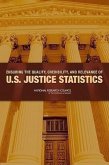"To derive statistics about crime - to estimate its levels and trends, assess its costs to and impacts on society, and inform law enforcement approaches to prevent it - a conceptual framework for defining and thinking about crime is virtually a prerequisite. Developing and maintaining such a framework is no easy task, because the mechanics of crime are ever evolving and shifting: tied to shifts and development in technology, society, and legislation. Interest in understanding crime surged in the 1920s, which proved to be a pivotal decade for the collection of nationwide crime statistics. Now established as a permanent agency, the Census Bureau commissioned the drafting of a manual for preparing crime statistics--intended for use by the police, corrections departments, and courts alike. The new manual sought to solve a perennial problem by suggesting a standard taxonomy of crime. Shortly after the Census Bureau issued its manual, the International Association of Chiefs of Police in convention adopted a resolution to create a Committee on Uniform Crime Records --to begin the process of describing what a national system of data on crimes known to the police might look like. Report 1 performed a comprehensive reassessment of what is meant by crime in U.S. crime statistics and recommends a new classification of crime to organize measurement efforts. This second report examines methodological and implementation issues and presents a conceptual blueprint for modernizing crime statistics"--Publisher's description.
Bitte wählen Sie Ihr Anliegen aus.
Rechnungen
Retourenschein anfordern
Bestellstatus
Storno



